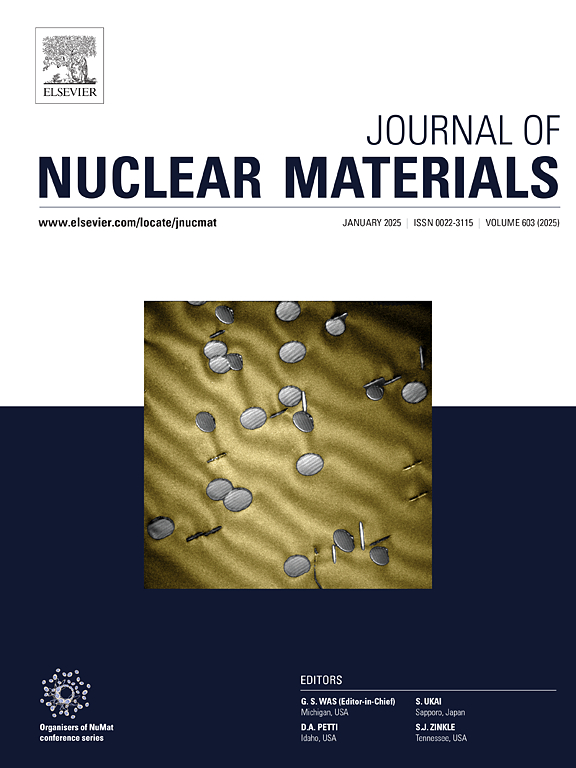Exploring the Peak Cladding Temperature Limit of Cr-coated ATF Cladding by Assessing the Impact of the Zr-Cr Eutectic on the Structural Integrity of Cladding
IF 2.8
2区 工程技术
Q3 MATERIALS SCIENCE, MULTIDISCIPLINARY
引用次数: 0
Abstract
The formation of the Zr-Cr eutectic (∼1320 °C), which does not occur in conventional Zirconium alloys, introduces a significant safety concern for Cr-coated Accident Tolerant Fuel (ATF). This study investigated the Peak Cladding Temperature (PCT) limit for Cr-coated ATF by examining the effects of the Zr-Cr eutectic on the mechanical integrity of Cr-coated Zr-1.1Nb claddings. To achieve this, Integral Loss of Coolant Accident (LOCA) tests and Ring Compression Tests (RCTs) were conducted on Cr-coated specimens under both steam and oxygen-free environments. The results indicated that while the formation of the eutectic phase between Zr and Cr does not result in structural failure, it reduced the ductility of the cladding. However, the impact of Zr-Cr eutectic on the reduction in ductility was overshadowed by the significant impact of the oxidation under the same conditions. The primary cause of the severe ductility loss in specimens oxidized above the eutectic onset temperature was the increased oxygen diffusion at elevated temperatures. Consequently, compared to specimens oxidized at 1204 °C, the increased oxygen concentration in the ductile layer further reduced the ductility of the cladding. Based on these findings, the pronounced reduction in ductility caused by oxidation of the Zr matrix in Cr-coated ATF cladding underscored the necessity of adhering to the current PCT limit, as long as the cladding matrix of Cr-coated ATF cladding remains Zirconium alloy. Furthermore, the excessive embrittlement observed in Zirconium alloy at temperatures above 2400 °F (1315 °C) was a key factor in establishing the current 2200 °F (1204 °C) PCT limit. As a result, extending the PCT limit beyond 1204 °C for Cr-coated ATF cladding is impractical, given the rapid oxygen diffusion and the consequent reduction in ductility at these higher temperatures. Therefore, maintaining the current 2200 °F (1204 °C) PCT limit for Cr-coated ATF cladding can serve as the effective approach for ensuring the safety of Cr-coated ATF cladding within the existing regulatory framework.
求助全文
约1分钟内获得全文
求助全文
来源期刊

Journal of Nuclear Materials
工程技术-材料科学:综合
CiteScore
5.70
自引率
25.80%
发文量
601
审稿时长
63 days
期刊介绍:
The Journal of Nuclear Materials publishes high quality papers in materials research for nuclear applications, primarily fission reactors, fusion reactors, and similar environments including radiation areas of charged particle accelerators. Both original research and critical review papers covering experimental, theoretical, and computational aspects of either fundamental or applied nature are welcome.
The breadth of the field is such that a wide range of processes and properties in the field of materials science and engineering is of interest to the readership, spanning atom-scale processes, microstructures, thermodynamics, mechanical properties, physical properties, and corrosion, for example.
Topics covered by JNM
Fission reactor materials, including fuels, cladding, core structures, pressure vessels, coolant interactions with materials, moderator and control components, fission product behavior.
Materials aspects of the entire fuel cycle.
Materials aspects of the actinides and their compounds.
Performance of nuclear waste materials; materials aspects of the immobilization of wastes.
Fusion reactor materials, including first walls, blankets, insulators and magnets.
Neutron and charged particle radiation effects in materials, including defects, transmutations, microstructures, phase changes and macroscopic properties.
Interaction of plasmas, ion beams, electron beams and electromagnetic radiation with materials relevant to nuclear systems.
 求助内容:
求助内容: 应助结果提醒方式:
应助结果提醒方式:


